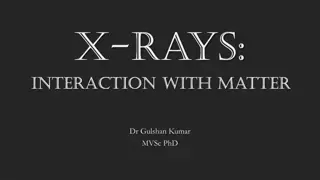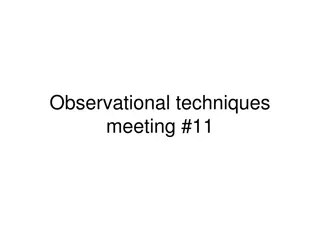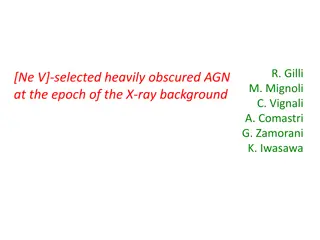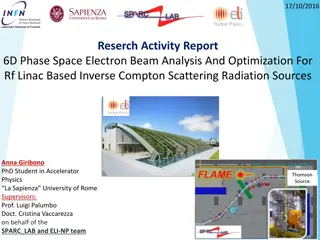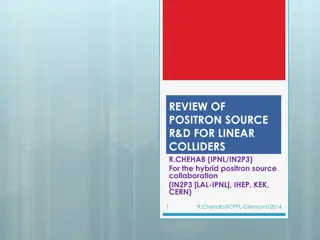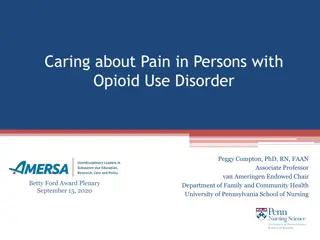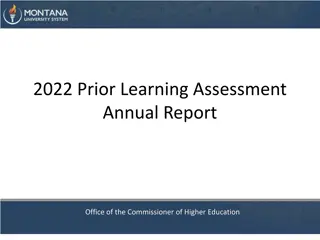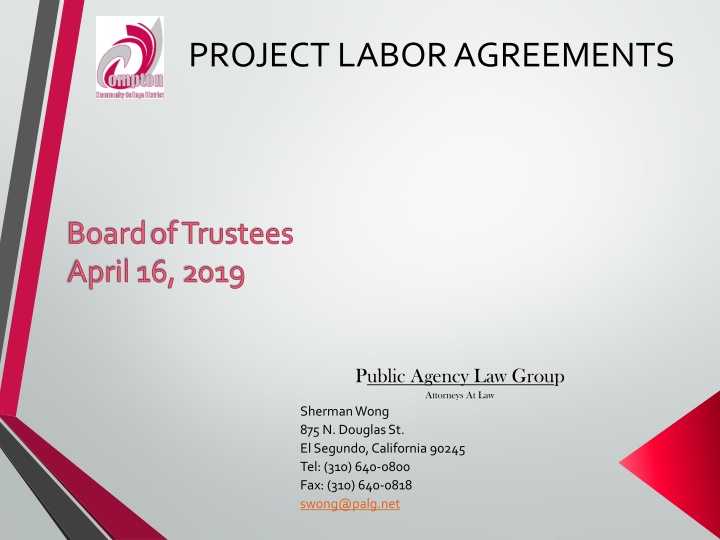
Project Labor Agreements and Legal Framework
Learn about Project Labor Agreements (PLAs), their legal authority, mandatory provisions, and board/district actions. PLAs are pre-hire collective bargaining agreements for construction projects. Legal cases and statutes provide the framework for implementing PLAs, ensuring fair practices and dispute resolution.
Download Presentation

Please find below an Image/Link to download the presentation.
The content on the website is provided AS IS for your information and personal use only. It may not be sold, licensed, or shared on other websites without obtaining consent from the author. If you encounter any issues during the download, it is possible that the publisher has removed the file from their server.
You are allowed to download the files provided on this website for personal or commercial use, subject to the condition that they are used lawfully. All files are the property of their respective owners.
The content on the website is provided AS IS for your information and personal use only. It may not be sold, licensed, or shared on other websites without obtaining consent from the author.
E N D
Presentation Transcript
PROJECT LABOR AGREEMENTS Boardof Trustees April 16, 2019 Public Agency Law Group Attorneys At Law Sherman Wong 875 N. Douglas St. El Segundo, California 90245 Tel: (310) 640-0800 Fax: (310) 640-0818 swong@palg.net
What is a PLA? Pre-hire collective bargaining agreement between the District and one or more labor organizations establishing terms and conditions for a specific project or group of projects (Public Contract Code 2500) Negotiated terms and conditions; scope and terms/conditions of PLA vary from PLA to PLA Other public works bidding/contract requirements unaffected by PLA Award to bidder submitting lowest priced responsive proposal Bond requirements (bid bond, payment bond, performance bond) Licensing and District established qualifications requirements Prevailing Wage Rates 2
Legal Authority for PLA Case Law Associated Builders and Contractors, Inc. v. San Francisco Airports Commission, California Supreme Court (1999) A public agency, acting as the owner of a construction project has legal authority to mandate a project labor agreement as a bid specification for the project. PLA does not exclude any contractor, union or nonunion, from bidding PLA does not extract contractors commitment toward the unions on any project not subject to PLA Statutory Public Contract Code 2500, enacted 2010 Authorizes PLA District discretion to enter into PLA, determine Project(s) subject to PLA and to establish PLA terms/conditions Mandatory taxpayer protection provisions 3
Mandatory PLA Provisions Non-Discriminatory Practices; 2500(a)(1) The agreement prohibits discrimination based on race, national origin, religion, sex, sexual orientation, political affiliation, or membership in a labor organization in hiring and dispatching workers for the project. Non-Union Contractor Participation; 2500(a)(2) The agreement permits all qualified contractors and subcontractors to bid for and be awarded work on the project without regard to whether they are otherwise parties to collective bargaining agreements. Drug Testing; 2500(a)(3) The agreement contains an agreed-upon protocol concerning drug testing for workers who will be employed on the project. No-Strike/No-Lock Out Commitments; 2500(a)(4) The agreement contains guarantees against work stoppages, strikes, lockouts, and similar disruptions of the project. Alternative Dispute Resolution; 2500(a)(5) The agreement provides that disputes arising from the agreement shall be resolved by a neutral arbitrator. 4
Board/District Actions Majority Board vote necessary to adopt PLA Public Contract Code 2501: The members of the governing board of a local public entity may choose by majority vote Board discretion to designate projects subject to PLA Public Contract Code 2501: require contractors to enter into a project labor agreement that includes all the taxpayer protection provisions of Section 2500 for a specific project or projects awarded by that entity 5
Typical PLA Terms & Conditions Contractor and all subcontractors for trades/crafts included in PLA scope required to assent to and comply with terms of PLA, regardless of union or non- union status Project craft labor Union hiring hall labor; exclusive source of project craft labor or priority preference for union hiring hall labor Specific management and supervisory personnel not subject to union hiring hall Commitment of adequate labor resources Craft labor who are not union members not required to join union as condition of employment, but subject to union contributions and terms of PLA Uniformity of workdays, work hours, payday schedules Establish priority/preference for specific labor resources, i.e., local residents, veterans, etc. Labor disputes Unions no-strike commitment; management no lock-out commitment PLA project unaffected by expired collective bargaining agreement Alternative dispute resolution procedures for job-site labor disputes 6
Pros & Cons PLA Opponents: PLAs erode competitive bidding process; bid competition reduced if capable non-union contractors elect not to bid projects subject to PLA, potentially resulting in higher project costs Workforce and work assignments subject to union rules and collective bargaining requirements Union recruitment of craft labor Non-union craft laborers contributions for union representation and union health/benefits Loss of value for non-union craft labor mandated union contributions during project Increased project costs where collective bargaining wage rates exceed prevailing wage rates or inadequate bid competition Administrative burdens and costs to District for PLA negotiation, implementation and administration 7
Pros & Cons (Continued) PLA Proponents: Uniformity of wages, benefits, overtime pay, hours, working conditions, and work rules Capability and qualifications of craft labor Maximize timely project completion by: (i) commitment of a reliable and uninterrupted supply of qualified labor and (ii) elimination of job-site labor disturbances Minimize job-site labor disputes by alternative dispute resolution procedures Community benefits Preference/priority local residents craft labor hires Preference/priority for other under-represented groups i.e., veterans, women, minorities, etc. Construction industry skills training 8
Preliminary Considerations Trades/crafts included or excluded from PLA Project(s) subject to PLA Funding source Project value Projects constructed by project completion alternative to design-bid-build, i.e., design- build, lease-leaseback, etc. Exclusion of non-construction services related to PLA Project Project type; maintenance, energy conservation (Government Code 4217 and/or Prop 39), etc. Identify mutual interests of labor organizations and District for labor- management cooperation; health & welfare, quality control, site safety, productivity, etc. to be addressed in PLA Assess District administrative costs/burdens; adjust Project budgets to incorporate PLA costs 9
Preliminary Considerations (Continued) No Strikes No lock-outs Commitment of sufficient pool of skilled labor resources for Projects subject to PLA Mechanisms for binding labor disputes resolution process Community benefits commitments 10
Next Steps Board of Trustees establish District PLA objectives Potential PLA objectives Quality and craftsmansip equal to or exceeds non-PLA projects Construction cost not increased with PLA and project value not impaired by PLA Enhanced apprenticeship programs for designated groups i.e., students, veterans, and local residents Timely project completion 11
Next Steps (Continued) Board Committee or Task Force Define and Refine Board objectives Assess achievement of Board defined objectives with and without PLA Assess community and constituent expectations; assess meeting community and constituent expectations with and without PLA Report to Board with recommendations for proceeding or not proceeding to engage Building Trades Council in PLA discussions 12





